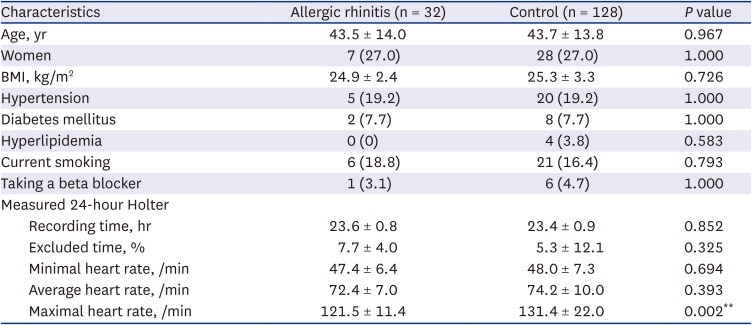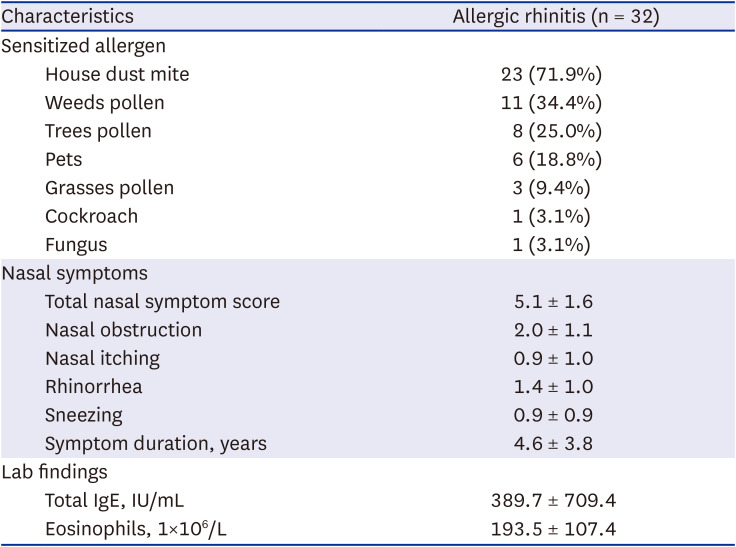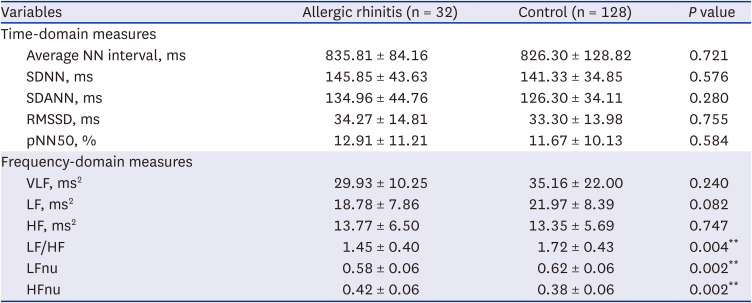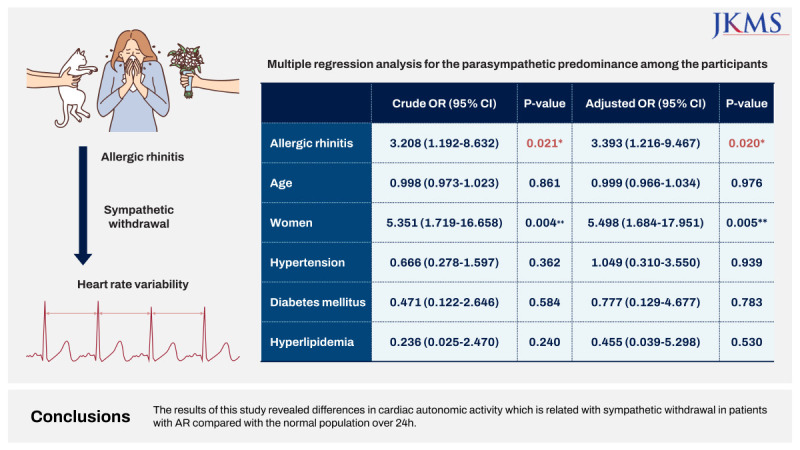1. Hong SN, Won JY, Nam EC, Kim TS, Ryu YJ, Kwon JW, et al. Clinical manifestations of allergic rhinitis by age and gender: a 12-year single-center study. Ann Otol Rhinol Laryngol. 2020; 129(9):910–917. PMID:
32425054.

2. Bousquet J, Van Cauwenberge P, Khaltaev N. Aria Workshop Group. World Health Organization. Allergic rhinitis and its impact on asthma. J Allergy Clin Immunol. 2001; 108(5):Suppl. S147–S334. PMID:
11707753.

3. Brożek JL, Bousquet J, Agache I, Agarwal A, Bachert C, Bosnic-Anticevich S, et al. Allergic Rhinitis and its Impact on Asthma (ARIA) guidelines-2016 revision. J Allergy Clin Immunol. 2017; 140(4):950–958. PMID:
28602936.
4. Ko JH, Kuo TB, Lee GS. Effect of postural change on nasal airway and autonomic nervous system established by rhinomanometry and heart rate variability analysis. Am J Rhinol. 2008; 22(2):159–165. PMID:
18416973.

5. Nam EC, Chun KJ, Won JY, Kim JW, Lee WH. The differences between daytime and nighttime heart rate variability may usefully predict the apnea-hypopnea index in patients with obstructive sleep apnea. J Clin Sleep Med. 2022; 18(6):1557–1563. PMID:
35088710.

6. Task Force of the European Society of Cardiology and the North American Society of Pacing and Electrophysiology. Heart rate variability. Standards of measurement, physiological interpretation, and clinical use. Eur Heart J. 1996; 17(3):354–381. PMID:
8737210.
7. Fournié C, Chouchou F, Dalleau G, Caderby T, Cabrera Q, Verkindt C. Heart rate variability biofeedback in chronic disease management: a systematic review. Complement Ther Med. 2021; 60:102750. PMID:
34118390.

8. Lan MY, Lee GS, Shiao AS, Ko JH, Shu CH. Heart rate variability analysis in patients with allergic rhinitis. Sci World J. 2013; 2013:947385.

9. Seppänen TM, Alho OP, Seppänen T. Dynamic changes in heart rate variability and nasal airflow resistance during nasal allergen provocation test. J Healthc Eng. 2016; 2016:1245418. PMID:
27196870.

10. Kim MH, Choi EJ, Jang BH, Kim KS, Ko SG, Choi I. Autonomic function in adults with allergic rhinitis and its association with disease severity and duration. Ann Allergy Asthma Immunol. 2017; 118(2):174–178. PMID:
28041676.

11. Zhu K, Chemla D, Roisman G, Mao W, Bazizi S, Lefevre A, et al. Overnight heart rate variability in patients with obstructive sleep apnoea: a time and frequency domain study. Clin Exp Pharmacol Physiol. 2012; 39(11):901–908. PMID:
23006023.

12. Lee WH, Kwon SO, Kim JW. Effectiveness of sleep surgery versus a mandibular advancement device for obstructive sleep apnea in terms of nocturnal cardiac autonomic activity. Sleep Breath. 2020; 24(4):1695–1703. PMID:
32162279.

13. Burr RL. Interpretation of normalized spectral heart rate variability indices in sleep research: a critical review. Sleep. 2007; 30(7):913–919. PMID:
17682663.

14. Agnihotri NT, McGrath KG. Allergic and nonallergic rhinitis. Allergy Asthma Proc. 2019; 40(6):376–379. PMID:
31690374.
15. Liu T, Xie C, Chen X, Zhao F, Liu AM, Cho DB, et al. Role of muscarinic receptor activation in regulating immune cell activity in nasal mucosa. Allergy. 2010; 65(8):969–977. PMID:
19951374.

16. Miraglia Del Giudice M, Marseglia GL, Leonardi S, Tosca MA, Marseglia A, Perrone L, et al. Fractional exhaled nitric oxide measurements in rhinitis and asthma in children. Int J Immunopathol Pharmacol. 2011; 24(4):Suppl. 29–32.

17. Bosmans G, Shimizu Bassi G, Florens M, Gonzalez-Dominguez E, Matteoli G, Boeckxstaens GE. Cholinergic modulation of type 2 immune responses. Front Immunol. 2017; 8(8):1873. PMID:
29312347.

18. Ozsutcu M, Ozkaya E, Demir A, Erenberk U, Sogut A, Dundaroz R. Pupillometric assessment of autonomic nervous system in children with allergic rhinitis. Med Princ Pract. 2013; 22(5):444–448. PMID:
23615331.

19. Ishman SL, Martin TJ, Hambrook DW, Smith TL, Jaradeh SS, Loehrl TA. Autonomic nervous system evaluation in allergic rhinitis. Otolaryngol Head Neck Surg. 2007; 136(1):51–56. PMID:
17210333.

20. Emin O, Esra G, Ufuk E, Demiri A, Ayhan S, Rusen DM. Autonomic dysfunction and clinical severity of disease in children with allergic rhinitis. Int J Pediatr Otorhinolaryngol. 2012; 76(8):1196–1200. PMID:
22626475.

21. Wise SK, Lin SY, Toskala E, Orlandi RR, Akdis CA, Alt JA, et al. International consensus statement on allergy and rhinology: allergic rhinitis. Int Forum Allergy Rhinol. 2018; 8(2):108–352. PMID:
29438602.
22. Salsone M, Vescio B, Quattrone A, Roccia F, Sturniolo M, Bono F, et al. Cardiac parasympathetic index identifies subjects with adult obstructive sleep apnea: a simultaneous polysomnographic-heart rate variability study. PLoS One. 2018; 13(3):e0193879. PMID:
29518111.

23. Kufoy E, Palma JA, Lopez J, Alegre M, Urrestarazu E, Artieda J, et al. Changes in the heart rate variability in patients with obstructive sleep apnea and its response to acute CPAP treatment. PLoS One. 2012; 7(3):e33769. PMID:
22438995.

24. Kim JW, Kwon SO, Lee WH. Nocturnal heart rate variability may be useful for determining the efficacy of mandibular advancement devices for obstructive sleep apnea. Sci Rep. 2020; 10(1):1030. PMID:
31974381.

25. Tascilar E, Yokusoglu M, Dundaroz R, Baysan O, Ozturk S, Yozgat Y, et al. Cardiac autonomic imbalance in children with allergic rhinitis. Tohoku J Exp Med. 2009; 219(3):187–191. PMID:
19851046.

26. Yokusoglu M, Ozturkt S, Uzun M, Baysan O, Demirkol S, Caliskaner Z, et al. Heart rate variability in patients with allergic rhinitis. Mil Med. 2007; 172(1):98–101. PMID:
17274276.

27. Cygankiewicz I, Zareba W. Heart rate variability. Handb Clin Neurol. 2013; 117:379–393. PMID:
24095141.

28. Koenig J, Thayer JF. Sex differences in healthy human heart rate variability: A meta-analysis. Neurosci Biobehav Rev. 2016; 64:288–310. PMID:
26964804.

29. Du XJ, Fang L, Kiriazis H. Sex dimorphism in cardiac pathophysiology: experimental findings, hormonal mechanisms, and molecular mechanisms. Pharmacol Ther. 2006; 111(2):434–475. PMID:
16439025.

30. Nugent AC, Bain EE, Thayer JF, Sollers JJ, Drevets WC. Sex differences in the neural correlates of autonomic arousal: a pilot PET study. Int J Psychophysiol. 2011; 80(3):182–191. PMID:
21414364.

31. Kay MW, Jain V, Panjrath G, Mendelowitz D. Targeting parasympathetic activity to improve autonomic tone and clinical outcomes. Physiology (Bethesda). 2022; 37(1):39–45. PMID:
34486396.

32. Klein HU, Ferrari GM. Vagus nerve stimulation: A new approach to reduce heart failure. Cardiol J. 2010; 17(6):638–644. PMID:
21154273.








 PDF
PDF Citation
Citation Print
Print




 XML Download
XML Download